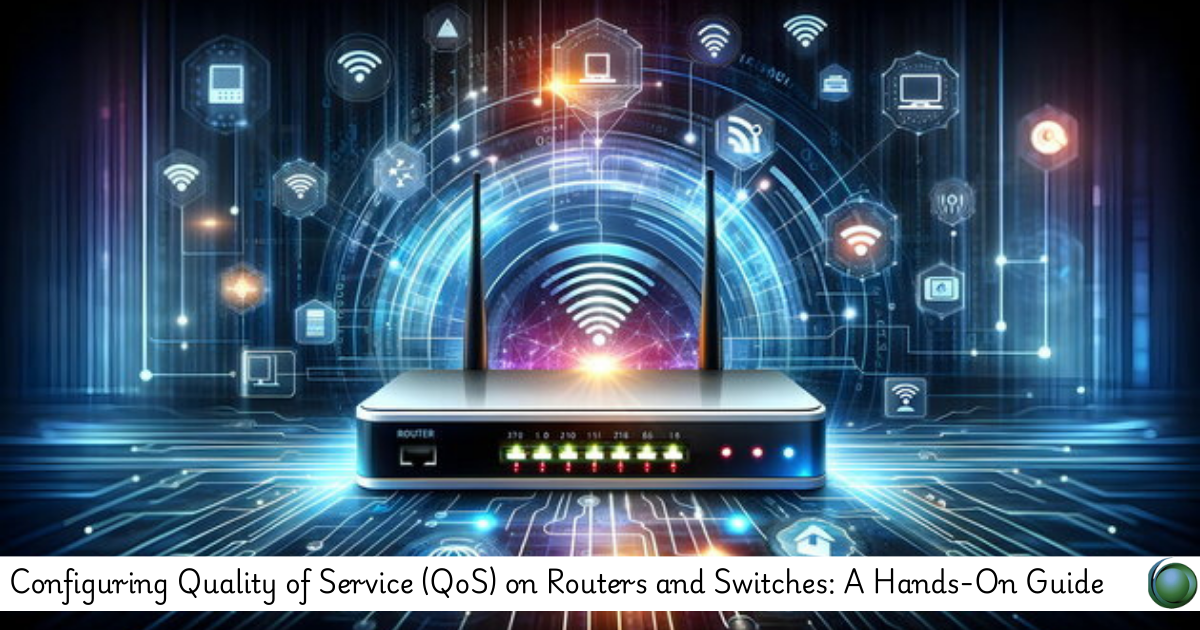Description
Introduction of QoS on Routers and Switches
Quality of Service (QoS) is a critical aspect of network management, especially in environments where high-priority applications like voice, video, and critical data must function seamlessly. Routers and switches play a crucial role in implementing QoS policies that ensure efficient traffic management, prioritization, and congestion control across the network. This hands-on guide walks you through the steps of configuring QoS on routers and switches, demonstrating best practices for optimizing traffic flows and guaranteeing service levels for time-sensitive applications.
Prerequisites
- Basic understanding of networking concepts such as IP addressing, routing, and switching.
- Familiarity with QoS terminology such as traffic classification, marking, scheduling, and policing.
- Basic knowledge of Cisco IOS or similar network operating systems.
- Hands-on experience with routers and switches in a lab or test environment.
Table of Contents
1. Introduction to QoS Configuration
1.1 Understanding QoS and Its Importance(Ref: Troubleshooting Quality of Service (QoS) Issues in Enterprise Networks)
1.2 Key Concepts: Traffic Classification, Marking, Policing, Shaping, and Scheduling
1.3 Overview of QoS Mechanisms in Routers and Switches
2. Basic QoS Configuration Principles
2.1 Identifying Traffic Types: Voice, Video, and Data
2.2 Setting Up Traffic Classes and Prioritizing Traffic
2.3 Applying QoS Policies to Interfaces and VLANs
3. Traffic Classification and Marking
3.1 Classifying Traffic Based on Layer 2 and Layer 3 Information
3.2 Marking Packets with DSCP and IP Precedence
3.3 Tools for Traffic Classification and Marking in Cisco Routers and Switches
4. Queuing Mechanisms: FIFO, Weighted Fair Queuing (WFQ), and Priority Queuing
4.1 First-In-First-Out (FIFO) Queuing for Basic Traffic Management
4.2 Weighted Fair Queuing (WFQ): Fair Traffic Distribution
4.3 Configuring Priority Queuing for Time-Critical Traffic
4.4 Choosing the Right Queuing Mechanism for Different Traffic Types
5. Congestion Management with Traffic Policing and Shaping
5.1 Understanding Traffic Policing: Rate Limiting and Traffic Enforcement
5.2 Traffic Shaping for Smooth Traffic Flow and Peak Traffic Handling
5.3 Configuring Policing and Shaping on Routers and Switches
6. Configuring QoS on Cisco Routers
6.1 Step-by-Step QoS Configuration on Cisco Routers
6.2 Applying QoS to WAN Interfaces(Ref: Quality of Service (QoS) for Voice and Video Traffic: Ensuring Quality Communication)
6.3 Implementing QoS on VPNs and IPsec Tunnels
6.4 Troubleshooting QoS Configuration on Routers
7. Configuring QoS on Cisco Switches
7.1 Step-by-Step QoS Configuration on Cisco Switches
7.2 Enabling QoS on Layer 2 Switch Ports and VLANs
7.3 Using 802.1p and DSCP Marking on Switch Ports
7.4 Verifying and Troubleshooting QoS on Switches
8. End-to-End QoS: Configuring QoS Across Routers, Switches, and End Devices
8.1 Implementing End-to-End QoS for Unified Communications and VoIP
8.2 Best Practices for QoS Across Different Network Segments
8.3 Integrating QoS with Network Monitoring Tools
9. QoS Policy Best Practices
9.1 Defining QoS Policies for Critical Applications
9.2 Managing Bandwidth for High-Priority and Low-Priority Traffic
9.3 Monitoring and Adjusting QoS Policies Based on Traffic Patterns
10. Troubleshooting QoS Configurations
10.1 Common QoS Configuration Issues and Solutions
10.2 Using Tools: Ping, Traceroute, and SNMP for QoS Troubleshooting
10.3 Troubleshooting QoS in High-Traffic Scenarios
11. Conclusion and Future Trends in QoS Configuration
11.1 Summary of Key QoS Configuration Techniques
11.2 Preparing for Future QoS Demands in High-Bandwidth Applications
11.3 The Role of SDN and Automation in QoS Configuration
Configuring QoS on routers and switches is essential for ensuring that critical traffic, such as voice and video, is prioritized over less time-sensitive data in a network. By understanding and applying QoS principles such as traffic classification, marking, queuing, policing, and shaping, network engineers can optimize network performance and deliver high-quality experiences for real-time applications. This guide has provided a hands-on approach to QoS configuration, giving you the tools and knowledge to implement robust QoS policies across routers and switches. With these techniques, you’ll be equipped to handle the increasing demands of modern networks, ensuring that your organization’s voice and video communications remain clear and uninterrupted.







Reviews
There are no reviews yet.